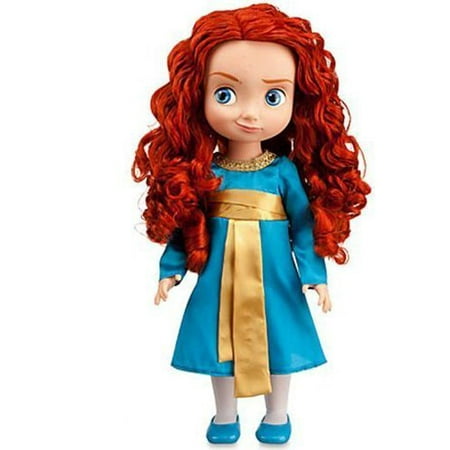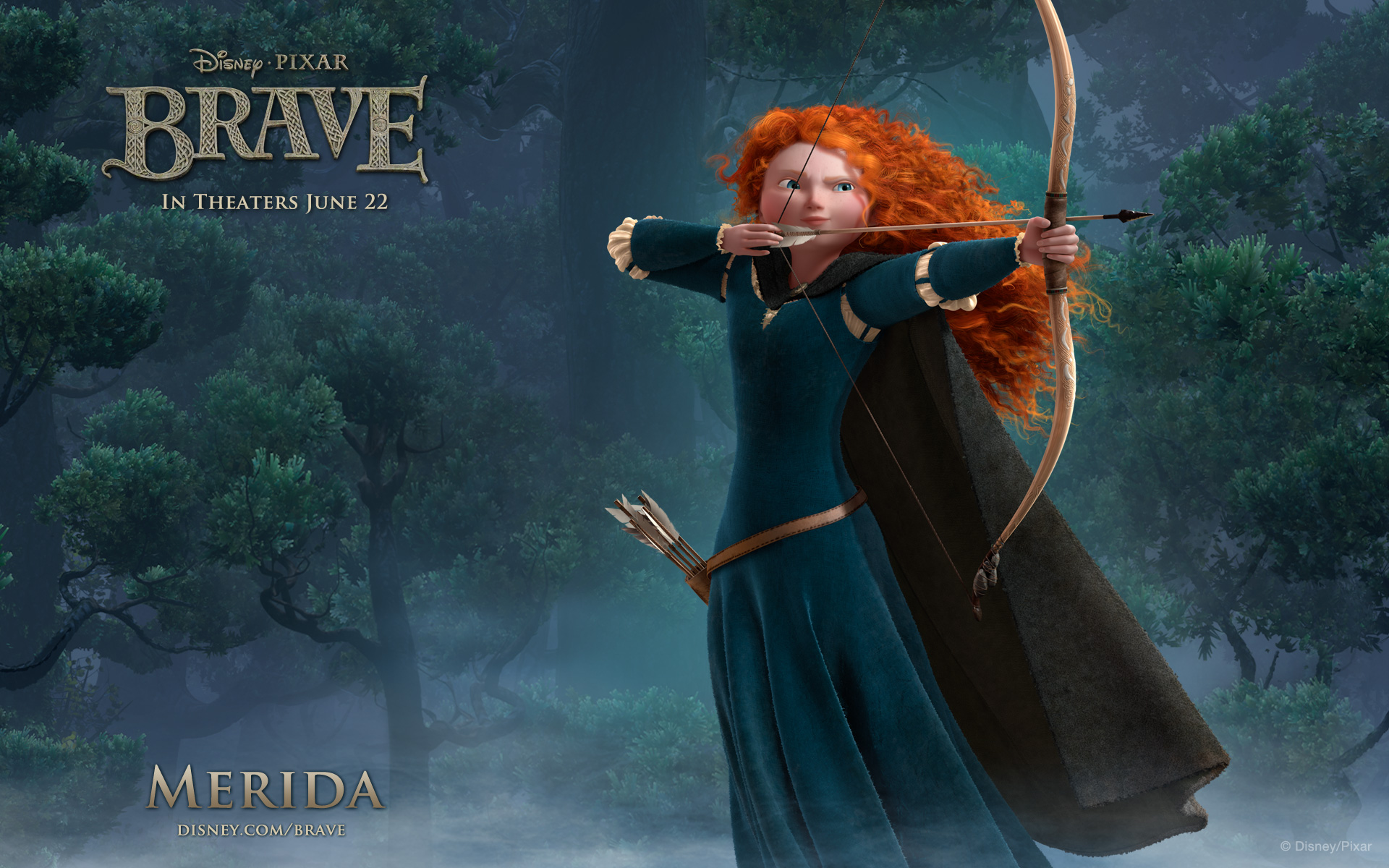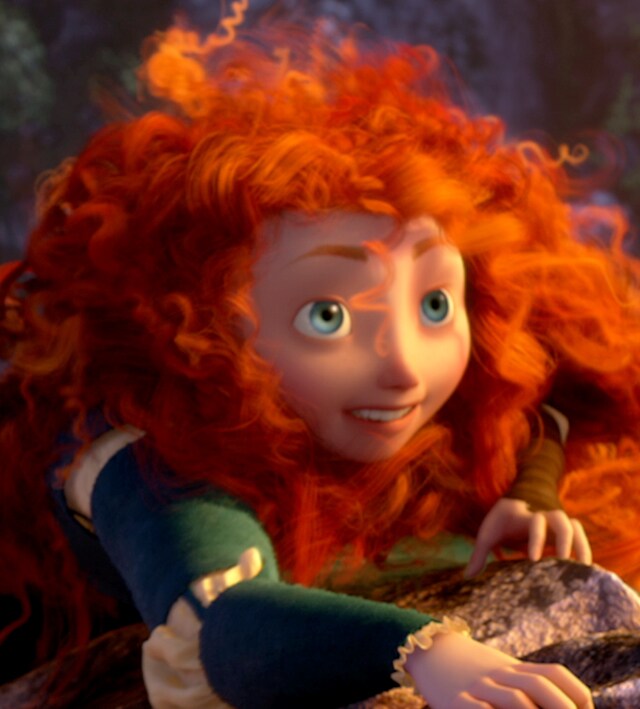Merida's explosion of fiery ringlets started as a series of springs on a computer. The Pixar team created many kinds of springs, including short, long, fat, thin, stretched, compressed, bouncy and stiff. In order to give Merida's hair volume, the springs were entered on the computer screen in layers. Disney/Pixar's Brave, releasing exclusive in 3D from 21st June onwards, and releasing nationwide from 28th June onwards.A grand adventure full of heart, memo.
NPR’s sites use cookies, similar tracking and storage technologies, and information about the device you use to access our sites (together, “cookies”) to enhance your viewing, listening and user experience, personalize content, personalize messages from NPR’s sponsors, provide social media features, and analyze NPR’s traffic. This information is shared with social media, sponsorship, analytics, and other vendors or service providers. See details.
You may click on “Your Choices” below to learn about and use cookie management tools to limit use of cookies when you visit NPR’s sites. You can adjust your cookie choices in those tools at any time. If you click “Agree and Continue” below, you acknowledge that your cookie choices in those tools will be respected and that you otherwise agree to the use of cookies on NPR’s sites.

Brave is Pixar’s 13th movie. It’s about a flame-haired princess named Merida (voiced by Kelly Macdonald) who doesn’t want to get married. She’d rather ride her horse, drink from waterfalls and wield her bow and arrow, like a medieval Katniss. The animation giant has featured female characters in its movies, including adorable Boo in Monsters, Inc., daffy Dory in Finding Nemo, feisty chef Colette in Ratatouille, the clever robot Eve in WALL•E and ant princess Atta in A Bug’s Life. But Pixar has never made a girl the lead until now, just as it’s never had a woman direct one of its films until now.
Oh, wait. Brenda Chapman (The Prince of Egypt)was the director of Brave, until she was replaced in the last 18 months of production by Mark Andrews, and the halfway-there aspect of that triumph serves as an apt metaphor for Pixar’s halfway embrace of female empowerment within the text of Brave. Merida is strong, capable and courageous. But depressingly, she’s a princess, the most traditional role for female characters in children’s fictions. She’s a rebellious tomboy, but her concerns are still limited to those of a princess, the biggest of which remains, as ever, marriage.

(MORE:Brave Old Worlds: Does Pixar Have a Problem with Stereotypes?)
Pixar is full of brilliant, flexible minds, the kind that made credible heroes out of a stuffed Wild West sheriff, an assortment of worker-bee types, including an ant and a robot, and a rat that dreamed of creating haute cuisine. It has been 17 years since the studio released its first movie, Toy Story, an awfully long time to get around to a female lead. I’m glad it finally got there, but I would have preferred that the studio’s groundbreaking moment had involved something actually groundbreaking.
“It’s a failure of imagination,” says writer Peggy Orenstein, author of the best-selling Cinderella Ate My Daughter: Dispatches from the Front Lines of the New Girlie-Girl Culture. (Full disclosure: Orenstein and I were once in a writing group together, and she also blurbed a book I wrote. I’m grateful, but she’d be the go-to person on the topic of princesses regardless.)
She’s talking about the nature of the character, but it is also true that the movie itself, while nowhere near the low point of last summer’s Cars 2, doesn’t dazzle. Train simulator free rolling stock. The animation is beautiful, but the story is staid. It is set in medieval Scotland, where Merida has just come of age and her mother Queen Elinor (Emma Thompson) is preparing to marry her off to any of three candidates from the other clans. This is tradition, intended to keep the peace among clans with a history of warfare, and therefore it’s Merida’s duty.
(MORE:The War on Women Begins with Girls)
Although Queen Elinor has a Susan Sontag–style white streak in her hair, she’s Miss Manners in a crown. A princess doesn’t raise her voice. She is “cautious,” “clean” and “above all, strives for perfection.” Elinor hardly considers marriage the end of the world; she actually loves her buffoonish husband Fergus (Billy Connolly). But for Merida, it feels like the end of freedom. Stewing with resentment, she consults a witch to change her mother’s mind but doesn’t stop to read the fine print.
The best parts of Brave are the scenes involving the changed Queen Elinor, now a gigantic bear. But despite a lot of superficial talk of fate — “Our fate lies within us. You only have to be brave enough to see it” — her physical metamorphosis represents the main transformation. Other than deciding her mother isn’t so bad, Merida doesn’t really grow. She’s simply extended her time as a tomboy, another archetype, less a girl than a stereotype of a kind of girl. “It wasn’t clear to me what her arc was,” Orenstein says. “What is it that we are imagining girls moving toward here? ‘I get to ride around on a horse all day’ isn’t really enough. That isn’t going to take her anywhere. There wasn’t a desire to do something.”
This wouldn’t feel so vaguely unsatisfying if Brave were just one of many Pixar movies that featured a strong female lead. It’s the absence of others that turns the spotlight on Brave. And having a princess protagonist isn’t inherently bad. It’s just that she is so chapter one of what girls can be — and so many other Pixar movies skipped most known chapters and moved on to whole new volumes.
Kingdom come deliverance console command to save. (PHOTOS:A Brief History of Pixar)

I did wonder if Pixar went with the princess concept in Brave with an eye toward subverting the tired (ahem, Disney) genre by attacking it head on, making this princess so defiantly different that all the other princesses would pale in comparison. If so, the studio hasn’t carried it off. Merida has red hair. She can shoot like Hawkeye in The Avengers. But Mulan accomplished more. Susan in Monsters vs. Aliens grew more (literally and figuratively), even if, as Orenstein points out, she could have used “a few more pixels in her waist.” Tiana in Disney’s The Princess and the Frog, the first black female lead for the studio,had a job and an ambition. I’d rather have seen Pixar make Remy’s daughter its first female lead in a Ratatouille sequel (Ratatouille 2: The Leftovers).

Girls of all ages need to see female characters in leading roles — whether they can shoot a bow and arrow like The Hunger Games’ Katniss or unabashedly embrace their gloriously imperfect bodies like Lena Dunham in Girls. Cultural equality is essential to broader equality. The images we see don’t have to be idealized and role models. They don’t need crowns. Average sorts of girls being represented in and incorporated into stories as leading characters can and will empower future feminists. And it’s just as crucial for those who might never call themselves by that name to see themselves on screens large and small because they still need to get jobs and find their way in the world.
(MORE:Brave: The Princess and Her Unbearable Mom)
Moreover, it’s not only girls who need these images. When I told my 8-year-old son we were going to see Brave, you’d think I’d have told him school was not out for the summer after all and that I was making him a spinach sandwich. He was vague about why he didn’t want to see it, and when I asked directly, he claimed it had nothing to do with the lead character’s being a girl. It might have been harder to get him into a seat, and the bear scared him, but in the end, he said he liked it very much. (Of course, his favorite characters were Merida’s little brothers, a trio of naughty, carrot-topped imps.) Will having seen Brave make him one day be more respectful of his college girlfriend? Who knows? I could use all the help I can get in nurturing a good future man.
I have no doubt there are a lot of good men at Pixar, but if they’d grown up in an environment in which it was totally normal for them to see movies with girls in the lead, maybe it wouldn’t have taken 17 years for the studio to get around to making a girl the star. And I’m with Orenstein in hoping that Brave does well enough to encourage the studio to make more movies with girls in the lead. (Pixar’s Pete Docter, director of Up, is reportedly working on a film that takes place inside a girl’s mind.) “The fact that we have to put this much analysis into this movie is really a symptom of the problem,” Orenstein says. “I just want to see such a broad range of female characters onscreen that we don’t have to have a discussion every time one comes out.” Exactly. Believe it or not, I’d love to shut up about the topic.
Pixar Merida Brothers
PHOTOS:Behind the Scenes with Pixar’s Brave




